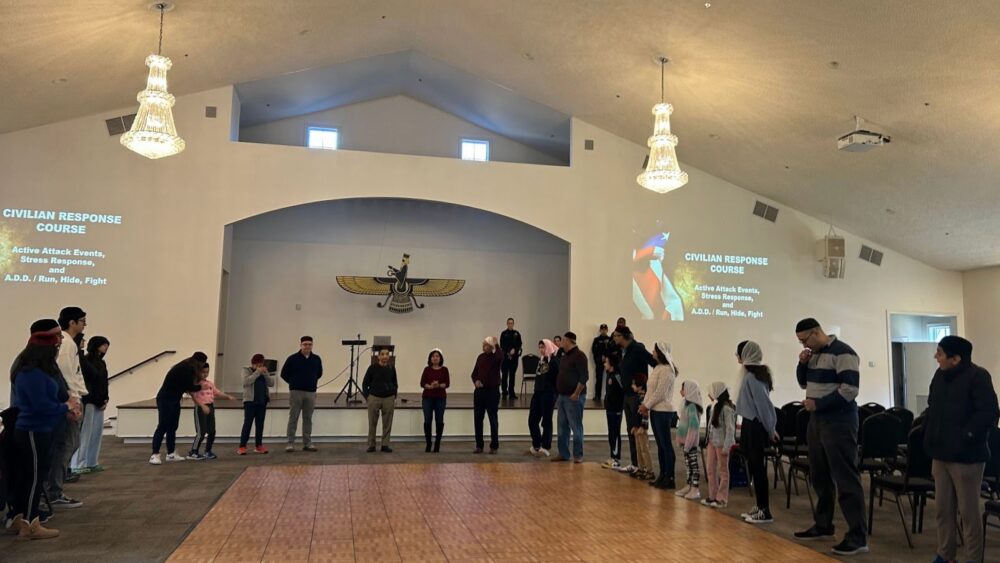
SUFFERN, N.Y. — Just before noon on a recent Sunday, about 50 Zoroastrian men and women stood in a circle clasping hands inside of the Dar-E-Mehr fire temple in this village about a 40-minute drive north of Manhattan. It is here, at 106 Pomona Rd., where Zoroastrians in the tri-state area meet monthly to pray and educate their youth.
Each person in the circle covered their head with either a shawl or a short cylindrical cap, called a topee. Some worshippers, including Khursheed Navdar, the prayer leader and the president of the Zoroastrian Association of Greater New York, shut their eyes, meditating while reciting the prayers. Others, including the many children, curiously peered at their fellow circle mates.
After Navdar finished the prayers, she opened the circle up for announcements. A mother introduced her kindergartener who was starting the religion education course, and a high school senior announced his cancer research fundraiser. Navdar instructed the adults to stay in the main auditorium for emergency response training while the children happily clambered up the stairs to their respective classrooms.
Inside one of the classrooms, Avan Patel, the daughter of a Zoroastrian priest, was preparing selections from children’s books on the faith. Patel’s lesson plan for the day was to introduce the Navjote — the religious induction ceremony for girls and boys between the ages of 7 and 15. It is also when a child receives a white cotton shirt (Sudreh) and woolen cord (Kusti), the ceremonial clothing that Zoroastrians wear every day as a kind of armor against evil. Patel settled on a book that describes the Navjote from the perspective of a young boy named Dinyar, which she said makes the ceremony more relatable for the children who may not have had their Navjote yet.
Patel, 47, fell in love with her religion courses as a child, leading her to start teaching her own Zoroastrian prayer and culture courses in 1998.
“As an adult, you realize the value of these Zoroastrian traditions, stories and prayers, and how they help you understand your identity in an overwhelming world,” Patel said. “Teaching the Zoroastrian children the ways of our religion makes me feel proud and happy as if I was a representative of our ancestors.”
Patel stood at the front of the room alongside her former student, Aaria Nadar, 17, who was now her teaching assistant. The four wide-eyed 7-year-olds in their class looked up intently as Nadar wrote “Navjote = new birth” on the whiteboard. To provide a mental image of the ceremony for the young ones, Nadar took out an iPad and began swiping through photos of her and her sister’s shared Navjote ceremony a few years ago in India.
“There’ll be older children who’ll guide and explain concepts to younger kids,” Patel said after the class, “and that always makes me smile, knowing that they’re learning and wanting to spread their knowledge with others.”
Patel explained how the ceremony lasts about 45 minutes and ends with the priest, or Dasturji, performing a blessing by showering the child with rose petals and rice. Afterwards, the child is dressed in new clothing and jewelry for a celebration. Oftentimes, the celebration includes a special dinner, called a Parsi Bonu, in which friends and family eat off banana leaves.
Patel then called for a volunteer. There were two girls and two boys in the class and both the girls raised their hands. Patel chose one, telling her, “Let’s pretend it’s your Navjote.” Nadar helped the girl put on the Sudreh. Patel pointed out the small pocket on the shirt’s front — “the pocket of good deeds,” representing the third and final aspect of the religion’s three-pronged motto: “good thoughts, good words, good deeds.” Patel and Nadar guided the girl to hold the Kusti, the sacred wool string, correctly: folded once and held taut horizontally across the body with one thumb holding the loop. The little girl helpfully reminded them to not let the Kusti touch the ground.
“Let the Sudreh and Kusti be the badge of service to Ahura Mazda [God],” Patel said. “These things that we wear on our body protect us, and it’s something to feel honorable about.”
Patel pointed to a photo of a bearded man and asked the children who it was: Ahura Mazda (the God) or Zarathustra (the prophet). Silence. “Ahura Mazda?” a young girl questioned. It was Zarathustra.
“Is God a human being?” Patel asked the children. “No,” Patel continued. “He’s a special force. We can’t see him, but he’s everywhere. And his name, just like we all have names, is Ahura Mazda. Zarathustra is a man on earth, just like us, and the son of God.”
To end the class, Patel pointed again to the photo of the bearded man and asked, “If you think it’s Zarathustra, raise your hand.” This time, the hands of all four children shot up in unison. Patel smiled.
“We all learn by either repetition or experience,” Patel said. “When I present a lesson to the kids by telling a story, writing notes on the whiteboard or doing arts and crafts relating to the lesson — it brings it to life.”
